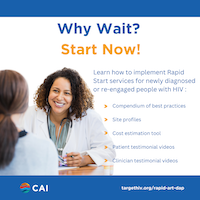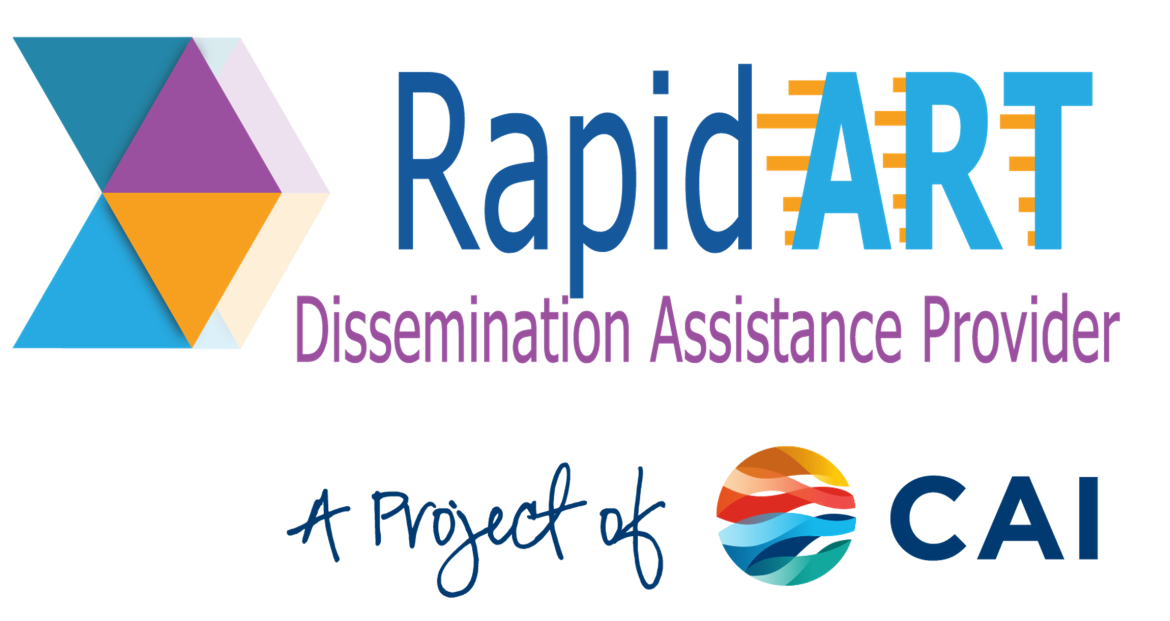
Tony Jimenez, MD, MA, CAI Senior Vice President
As an HIV service professional, you know that hopes for ending the HIV epidemic depend in large measure on maximizing the benefits of antiretroviral treatment (ART) by making sure clients receive treatment as soon as possible. Providing ART to people within seven days of new HIV diagnosis or re-engagement in care —Rapid Start— has been shown to increase rates of ART uptake and markedly reduces time to viral suppression compared to later ART initiation.
The question for health care professionals is often not whether to implement Rapid Start, but how.
Identifying Rapid ART Models
In response, since 2020, the HRSA-funded Rapid Antiretroviral Treatment Dissemination Assistance Provider (DAP) project has been working with Ryan White HIV/AIDS Program (RWHAP)-funded programs (i.e., clinical teams, Part A/B staff, CBOs) to identify innovative and effective models for providing Rapid Start for people who test newly positive for HIV—or are re-engaging in care.
While conducting field visits, CAI, the DAP project coordinator, interviewed over 150 diverse RWHAP providers from across the country, and the clients they serve. They described the positive impact on HIV care continuum outcomes that result from providing Rapid Start services. We packaged what we learned into a set of resources that showcase best practices for implementing Rapid Start.
View the following highlights of the entire collection of Rapid ART resources.
Compendium of Rapid Start Best Practices
In the Compendium of Best Practices in Provision of Rapid Start Services for People with HIV, you’ll find information describing the core elements of providing Rapid Start services and associated best practices identified by your peers, including: planning for and building buy-in for Rapid Start services; how to finance Rapid Start services and ensure same-day access to ART; and Rapid Start workflows and staff roles and key tasks.
“Being able to build the flexibility into the schedule was essential....” Compendium of Best Practices in Provision of Rapid Start Services for People with HIV.
Rapid Start Service Delivery Models
Rapid Start Service Delivery Models presents eight diverse Rapid Start sites— including Health Centers, and hospital-based and health department providers—featuring: descriptions of how Rapid Start services were financed and tailored; site-specific process maps, staff roles and key tasks; and cost estimates for implementation and sustainment of services.
Rapid Start Cost Estimate Tool
The Rapid Start Cost Estimate Tool will assist providers who want to implement Rapid Start services in estimating costs associated with planning, implementing, and sustaining Rapid Start services.
Patient and Provider Perspectives
Rapid ART Community and Provider Perspective Videos is a series of four videos featuring the perspectives of clients and health care providers.
Clinician Perspective
“We really don’t see many patients disappear after that initial visit. They want to come back.” - Kerry Kay, MD - Asian Health Services, Oakland, CA
Patient Perspective
"If they didn’t give [medication] to me as soon as I found out I had HIV, I probably wouldn’t have taken it.” - Ramirez - Los Angeles, CA

